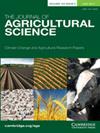子午黄单胞菌的生物防治。从百香果中分离细菌的西番莲
IF 1.7
4区 农林科学
Q2 AGRICULTURE, MULTIDISCIPLINARY
引用次数: 0
摘要
黄色百香果西番莲(Passiflora edulis Sims f. flavicarpa Deg)受到细菌Xanthomonas axonopodis pv的影响。引起细菌性枯萎病的染料,目前尚无有效的杀菌剂。利用活微生物处理害虫已显示出积极的控制效果。本研究旨在选择寄生于百香果层球的细菌作为防虫剂。passiflorae。从罗赖马州4个城市采集的百香树叶片中分离出所选细菌,并进行了耐热化合物试验和温室试验。共分离得到28株细菌。在耐热性化合物测试中,分离物RR02、RR04、RR06、RR14、RR16、RR17、RR19、RR20、RR21、RR22、RR23、RR25和RR27表现突出。在温室试验中,分离物RR03、RR07、RR09、RR13、RR16、RR21和RR23表现突出。结果表明,该方法具有防治青枯病的潜力。西番莲在体外和体内的试验。本文章由计算机程序翻译,如有差异,请以英文原文为准。
Biocontrol of Xanthomonas axonopodis pv. passiflorae With Bacteria Isolated From Passion Fruit
The yellow passion fruit Passiflora edulis Sims f. flavicarpa Deg is affected by the bacterium Xanthomonas axonopodis pv. passiflorae (Pereira) Dye, causing the bacterial blight disease, for which no effective bactericide is available. The use of live microorganisms in the treatment of pests have shown positive results in the control. This research sought to select bacteria residing in the passion fruit phyllosphere to function as a biocontrol agent of X. axonopodis pv. passiflorae. The selected bacteria were isolated from the passion fruit tree leaves collected in four municipalities of the state of Roraima, and thermostable compounds test and greenhouse test were performed. In total, 28 bacterial isolates were obtained. In the test with thermostable compounds, the isolates RR02, RR04, RR06, RR14, RR16, RR17, RR19, RR20, RR21, RR22, RR23, RR25, and RR27 stood out. In the greenhouse tests, the isolates RR03, RR07, RR09, RR13, RR16, RR21, and RR23 stood out. The results showed potential for the control of X. a. pv. passiflorae in in vitro and in vivo tests.
求助全文
通过发布文献求助,成功后即可免费获取论文全文。
去求助
来源期刊

Journal of Agricultural Science
农林科学-农业综合
CiteScore
2.80
自引率
5.00%
发文量
68
审稿时长
1.4 months
期刊介绍:
The Journal of Agricultural Science publishes papers concerned with the advance of agriculture and the use of land resources throughout the world. It publishes original scientific work related to strategic and applied studies in all aspects of agricultural science and exploited species, as well as reviews of scientific topics of current agricultural relevance. Specific topics of interest include (but are not confined to): all aspects of crop and animal physiology, modelling of crop and animal systems, the scientific underpinning of agronomy and husbandry, animal welfare and behaviour, soil science, plant and animal product quality, plant and animal nutrition, engineering solutions, decision support systems, land use, environmental impacts of agriculture and forestry, impacts of climate change, rural biodiversity, experimental design and statistical analysis, and the application of new analytical and study methods (including genetic diversity and molecular biology approaches). The journal also publishes book reviews and letters. Occasional themed issues are published which have recently included centenary reviews, wheat papers and modelling animal systems.
 求助内容:
求助内容: 应助结果提醒方式:
应助结果提醒方式:


